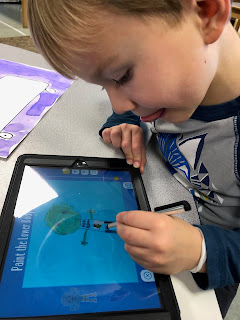At the end of the week, as children finished adding final details to one true story, we began the publishing process.
The children's work as storytellers and writers has been an ongoing and rich process. We have developed a culture of storytelling in our classroom, celebrating the language, sounds, expression, and
life in our stories. Children have worked hard to show
what,
who, and
where in their drawings and writing. They have used words to connect the parts in their stories together;
One day...Then...After that...Finally...
The publishing process involved the writers to think and record
what,
who, and
where. Again, this supported students stretching out words and writing the sounds they heard. For some, I transcribed their words. I was observing if students were able to think about and say the important details in their stories and continue to stick with
one true story.
Our publishing will be in the form of digital storytelling. Using an app, the children's drawings of their characters (who) and their background (where) will come alive.
On Friday morning the writers represented their characters on a larger scale, ensuring careful drawing and colorful details. Every child was able to say how many pieces of paper they needed, based on how many characters in their story. Following their drawing of
who, we worked on simple backgrounds using liquid watercolors to represent the
where of their stories.
This week, each child will use our storytelling app to tell their story one more time. I will put their stories together, creating a movie of our Kindergarten True Stories. Look in your email in the coming days for an invitation to a movie night celebrating the children's hard work as writers!



Using one of our pictures from building fairy houses, TB was able to look at and represent his mom- public documentation can support the drawing of the important people in our lives!
On Friday afternoon, DH practiced using our app- providing a visual for his peers as to what to expect in the coming week. Integrating technology in the Kindergarten classroom takes time, testing, and exploring. With the incredible help of Ms. Feller, we have another teacher to support the children's use of the storytelling app!






























































